Validation of a real-time bladder sensation meter during oral hydration in healthy adults: Repeatability and effects of fill rate and ultrasound probe pressure
Abstract
Objectives
A non-invasive protocol was previously developed using three-dimensional ultrasound and a sensation meter to characterize real-time bladder sensation. This study the protocol by measuring the effects of fill rateand ultrasound probe pressure during oral hydration.
Methods
Healthy volunteers with no urinary symptoms (based on International Consultation on Incontinence Questionnaire on Overactive Bladder surveys) were recruited into an oral hydration study. Throughout two complete fill–void cycles, participants drank 2 L Gatorade G2 (The Gatorade Company, Inc., Chicago, Illinois) and used a touch-screen sensation meter to record real-time bladder sensation (0%-100%). The study was repeated three times, once per week (Visits A, B, and C). In Visits A and B, ultrasound was used to measure bladder volume every 5 minutes. Ultrasound was not used in Visit C except at 100% capacity. Volume data from Visit B were used to estimate volumes throughout the fills in Visit C. Sensation–capacity curves were generated for each fill for comparative analysis.
Results
Ten participants completed three visits (60 total fills). Increased fill rate led to decreased sensation throughout filling, andultrasound probe pressure led to increased sensation. Participants reported higher sensation at low volumes during Fill 1 of Visit A before training with the sensation meter. Sensation curves with intermittent ultrasound showed repeatability for Fill 2 in Visits A and B. Fill rate and ultrasound probe pressure affect real-time bladder sensation during oral hydration.
Conclusions
This study demonstrated repeatability of real-time bladder sensation during a two-fill oral hydration protocol with ultrasound.




